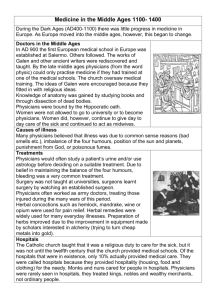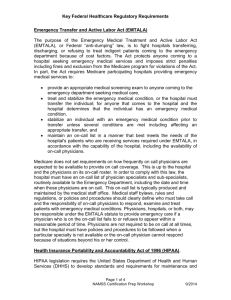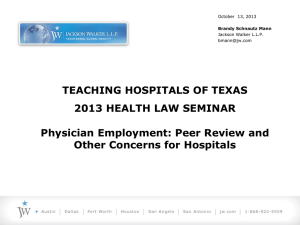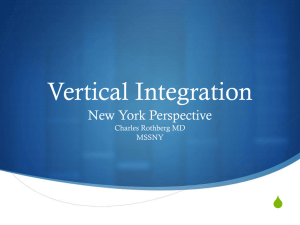Providence Health and Services - Association of Washington Public
advertisement
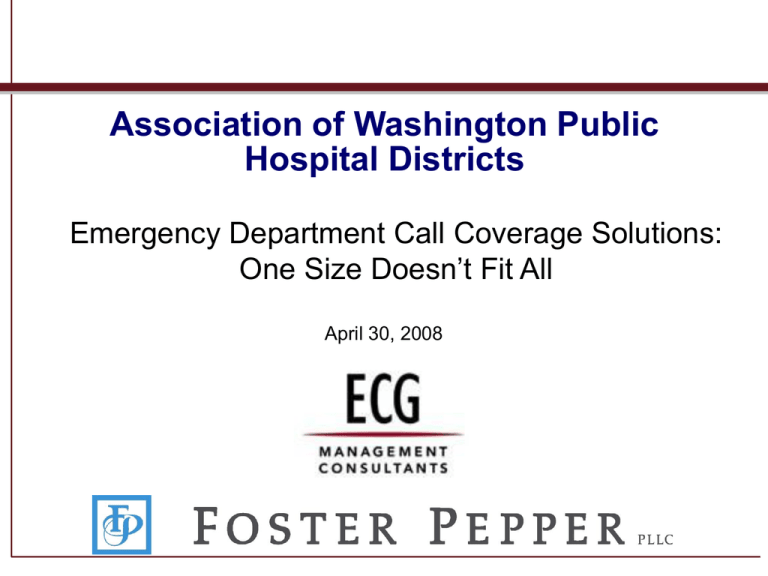
Association of Washington Public Hospital Districts Emergency Department Call Coverage Solutions: One Size Doesn’t Fit All April 30, 2008 Discussion Topics The purpose of this presentation is to summarize the various trends, both economic and regulatory, that are shaping emergency department (ED) call coverage solutions. Key topics to be addressed are listed below. National and Regional Trends – What are the national and regional trends in physician call coverage arrangements? Regulatory Update – What are government agencies or regulators saying about call coverage plans and related payments? Call Coverage Solutions – What are common (and not so common) methods of addressing physician requests to be paid for call? Case Studies – How are specific hospitals and their medical staffs addressing their particular situations? 785\90\124313(ppt) 1 National and Regional Trends Overview The past year has seen continued evolution and increased prevalence of ED call coverage plans. Key trends over the last year include: Increased Responses – While hospitals have been aware of the issue for some time, more organizations are adopting solutions (formal and informal). Operational “Fixes” – Hospitals are dedicating more effort and resources toward operational fixes aimed at decreasing the burden of call coverage. Guaranteed Reimbursement – Hospitals are increasingly considering (or implementing) guaranteed payment for uninsured (and often underinsured) patients. Focus on Surgical Specialists – If hospitals pay daily stipends, surgical/procedural specialties receive the majority of payments, while primary care physicians are typically excluded. 785\90\124313(ppt) 2 National and Regional Trends News Headlines Recent press coverage indicates that physician pressure for payments continues, and it is likely to be a major issue for the foreseeable future. Study: Hospital ERs Strained by Lack of On-Call Specialists 2007 The Daily Court Reporter ERs Scramble to Find On-Call Specialists The Boston Globe December 23, 2007 April 15, 2007 New Lure for Specialists to Answer the Call – Money Puget Sound Business Journal January 11, 2008 On-Call Specialists at Emergency Rooms Harder to Find, Keep The Washington Post December 21, 2007 Physicians’ On-Call System May Have to Go Through Changes or Die Columbus Business First July 16, 2006 Rising Fees for On-Call Specialists Have Hospitals Seeing Red Silicon Valley/San Jose Business Journal 785\90\124313(ppt) 3 October 21, 2006 National and Regional Trends News Headlines (continued) LRMC Pays On-Call Surgeon $700,000 The Ledger September 30, 2007 Get Me a Neurosurgeon, Stat! U.S. News & World Report January 21, 2007 In Shift, Doctors “On-Call” Get Pay; Hospitals Break With ER Tradition The Boston Globe April 15, 2007 Private Urologists to Be Paid for On-Call Treatment of the Poor The Washington Post February 12, 2007 Plan to Solve Emergency Room Crisis Reaches Impasse Sun-Sentinel February 6, 2008 If You Land in the Emergency Room, Don’t Count on Seeing a Specialist Sun-Sentinel July 16, 2006 Hospital Groups Make ER Palatable; Doctors Have Long Balked at On-Call System ` Portland Business Journal 785\90\124313(ppt) 4 July 21, 2006 National and Regional Trends Payment Trends In the past year, hospital expenditures for call coverage have increased, mostly due to local market pressures, call burden, and physician availability. 1 According to Sullivan, Cotter and Associates, Inc., roughly 60% of hospitals reported that their on-call expenditures increased in 2007.1 Some of the key factors impacting daily stipend rates for call coverage include:1 » Local market rates. » Frequency of call. » Likelihood of being called in when on call. » National market rates. Close to 15% of hospitals have closed one or more services in the past year due to the lack of physicians available to provide call coverage, including:1 » Neurosurgery. » Plastic surgery. » Oral/maxillofacial surgery. » Orthopedic surgery. » Neurology. » Ophthalmology. Source: Sullivan, Cotter and Associates, Inc.’s 2007 Physician On-Call Pay Survey Report (national data). 785\90\124313(ppt) 5 National and Regional Trends Payment Trends (continued) Physicians will continue to pressure hospitals for compensation to take call. A recent survey found that 81% of hospitals have implemented, or are considering implementing, plans and policies for physician on-call pay.1 Sullivan Cotter Survey Median (Daily Payment)2 ECG Survey Median (Daily Payment)3 General Surgery $750 $1,000 Orthopedic Surgery $968 $1,000 $1,175 $900 Other Surgical Subspecialties4 $478 $379 Medical Subspecialties5 $593 $400 Physician Type Neurosurgery NOTE: Payment statistics are based only on hospitals that are paying for ED call. 2 Source: Sullivan Cotter’s 2007 Physician On-Call Pay Survey Report (national data). Represents unrestricted call coverage, which means that physicians are not required to remain on hospital premises. Source: Sullivan Cotter’s 2007 Physician On-Call Pay Survey Report (national data). 3 National data collected from April 2005 through December 2007. 4 Includes cardiothoracic surgery, OB/GYN, ophthalmology, oral/maxillofacial surgery, orthopedic surgery – hand, otolaryngology (ENT), plastic surgery, trauma surgery, urology, and vascular surgery. 5 Includes cardiology, gastroenterology, internal medicine, and neurology. 1 785\90\124313(ppt) 6 National and Regional Trends Budget Benchmarks A study of 45 hospitals paying for call coverage indicates that annual budget for stipend payments ranges from 20 to 70 basis points of net revenue. Stipend Payments as a Percentage of Net Revenue1,2 0.80% 0.70% 0.60% 0.50% 0.40% 0.30% 0.20% 0.10% 0.00% 25th Percentile 50th Percentile 75th Percentile 1 Data based on ECG Management Consultants, Inc.’s proprietary call coverage database. Includes data from 45 hospitals across the country. 2 Net revenue data from American Hospital Directory, Inc. 785\90\124313(ppt) 7 Regulatory Update Overview of OIG Opinion In September, the OIG posted an advisory opinion1 on ED call coverage in response to a request from a large hospital regarding the appropriateness of its call coverage payment system. The hospital is a not-for-profit Catholic facility with a charitable mission. The facility has a high underinsured and uninsured patient population treated in the ED. Due to the financial burdens of uncompensated patient care and malpractice insurance costs, many physicians became unwilling to provide ED call without compensation. The lack of physician availability constrained the hospital’s ability to meet its specialty coverage needs. In response, an ad hoc committee was formed that developed a call coverage and uncompensated care arrangement to reduce physician burden while enabling the facility to provide the community with needed medical care. The OIG ruled that while the arrangement might “generate prohibited remuneration under the Anti-Kickback Statute,” the OIG would not impose administrative sanctions on the hospital for its system. 1 HHS OIG, Advisory Opinion No. 07-10, posted on September 27, 2007. 785\90\124313(ppt) 8 Regulatory Update OIG Opinion – Payment System The featured hospital chose a tiered per diem payment structure, based on specialty burden, for its call compensation system. High Per Diem Payment Tier Level Key Characteristics Level 1 – Primary Surgical Receive calls more frequently. General Surgery, Neurosurgery, Orthopedics Are likely to treat high-acuity patients. Level 2 – Secondary Surgical Receive calls less frequently. Must be prepared to perform surgery if called. Are less likely to be called. Call is more likely to be for consults. Level 4 – Hospital-Based Specialties Perform guaranteed level of service. Hospital Medicine, Anesthesiology Treat unassigned patients. Oral/Maxillofacial, Ophthalmology, ENT, Urology, OB/GYN Level 3 – Medical Subspecialties Infectious Disease, Cardiology, Neurology, Renal/Nephrology, Pulmonology, Endocrinology, Hematology/Oncology, Gastroenterology Low Per Diem Payment The payment system provides systematically larger payments for physicians taking weekend call, relative to weekday call. Further, all physicians are obligated to provide 1.5 days per month of uncompensated call coverage. 785\90\124313(ppt) 9 Regulatory Update OIG Opinion – Major Implications In commenting on the payment arrangement described, the OIG provides a great deal of guidance for other hospitals and their call coverage arrangements. Issue Fair Market Value (FMV) Compensation Implications for Hospitals The opinion did not address payment amounts but implied that the following elements of the program helped its case: The payment amounts resulted from a balanced process that utilized (1) an ad hoc committee of stakeholders to study the program and (2) payments that are indexed to physician call burden and the likelihood that physicians will be required to respond to ED calls. An outside expert opinion was obtained to certify that the payments represent FMV. Preference for Per Diem Payments Payments should be properly structured to avoid the appearance of unlawful remuneration. In general, the OIG implies that it prefers per diem payments for call over other methods. Potential for Kickbacks Compensation structures that might disguise kickback payments include: 785\90\124313(ppt) Payment structures that compensate physicians when no identifiable services are provided. Aggregate on-call payments that are disproportionately high compared to the physician’s regular medical practice income. Payment structures that compensate the on-call physician for professional services for which he/she receives separate reimbursement from insurers or patients, resulting in “double pay.” 10 Regulatory Update OIG Opinion – Major Implications (continued) Issue Implications for Hospitals Indigent Care The OIG clearly views the hospital’s requirements that physicians provide care to indigent patients and administer all inpatient followup care as providing “substantial, quantifiable services” because that puts physicians “at risk for having to furnish additional services for no additional payment.” Unmet Need Facilities should have a legitimate, unmet need for providing on-call coverage and uncompensated care. Unmet need should be documented to historically show problems in physicians’ unwillingness to take call and, consequently, the hospital’s inability to care for its patients. Openness to All Physicians The hospital’s inclusion of all physicians in the program was also an element that was viewed favorably by the OIG, as it reduces the likelihood that the payments are being channeled to the hospital’s biggest referrers. 785\90\124313(ppt) 11 Regulatory Update OIG Opinion – Major Implications (continued) Issue Implications for Hospitals Uniform Administration The payment should be administered uniformly for all doctors in a given specialty to lower the risk of the arrangement becoming a vehicle to disguise payments for referrals. Equal Distribution of Responsibilities The arrangement should be offered uniformly to all physicians in the relevant specialties. Call obligations should be divided as equally as possible to avoid the appearance of the schedule being used to selectively reward the highest referrers. Documentation of Program Outcomes Hospitals should require quality outcomes from their physicians on call and document the results as a way of measuring the success of call coverage arrangements. 785\90\124313(ppt) 12 Call Coverage Solutions Payment Trends Organizational Cost The cost (and stability) of call coverage plans increases as more formal arrangements between hospitals and medical staffs are established. Increasing Call Plan Stability No Pay Operational Reimbursement Support Guarantees Activation Payments Stipend Payments Call Strategies 785\90\124313(ppt) 13 Affiliation Agreements Employment Call Coverage Solutions Impact on Rural Hospitals Smaller hospitals, particularly rural hospitals, face considerable challenges in maintaining 24/7 coverage with a limited number of providers. Transfer Plan – Hospitals are increasingly using formal transfer plans to backfill uncovered days. Telemedicine – Physicians may use telemedicine services in certain situations to further evaluate or stabilize an emergency medical condition. » Specific rules exist regarding appropriate use of telemedicine without being in violation of EMTALA on-call requirements. » Reimbursement for telemedicine services is limited. Community/Regional Coverage – Some areas have successfully coordinated regional call coverage plans within specific specialties (e.g., all hand cases are referred to Hospital A). Payment Thresholds – Some hospitals are paying physicians for coverage after they have covered a certain number of “obligatory” days. 785\90\124313(ppt) 14 Call Coverage Solutions Medical Staff Involvement Involving your medical staff in the call coverage planning process can take different forms: an incremental (specialty-by-specialty) approach or a collaborative medical staff-wide approach. Incrementalism Medical Staff Involvement Quicker resolution of issue. Easier process to manage on the front end. Takes longer and requires more effort to resolve call issues. More likely to build sustainable support for plan in long term. Medical staff pressure can balance extreme specialty demands. Requires strong administrative and physician leadership. Tends to validate extreme opinions. Can antagonize other specialties. Can raise unrealistic expectations for call pay. Although an incremental approach to call planning can often resolve short-term crises, involving the medical staff in the process has a better chance of building a long-term, stable solution. 785\90\124313(ppt) 15 Call Coverage Solutions Planning Methodology Component A – Strategic Direction Situational Assessment Component B – Preferred Call Coverage Solutions Strategic Direction Plan Development Internal Analysis Call Coverage Options Background Assessment Interviews Call Coverage Burden Data Option 1 Deliverable Situational Assessment External Analysis Market Analysis National and Regional Trend Assessment 785\90\124313(ppt) Deliverable Develop Strategic Direction Option 2 Deliverable Option 3 Strategic Principles and Goals 16 Evaluate Strategic, Financial, and Operational Implications Select Preferred Plan Implementation and Communication Plan Case Studies To better understand the issues behind call coverage, we have outlined two different case studies from the West Coast. Case Study #1 A three-hospital system on the West Coast developed a tight affiliation with one neurosurgery group to address call coverage concerns. Case Study #2 Hospital administrators deferred to the medical staff to develop a budget-focused solution to the call coverage issue. 785\90\124313(ppt) 17 Case Study #1 Affiliation Arrangement Background on Neurosurgery Issue This case study involves a three-hospital system on the West Coast with the following attributes: Hospital Trauma Level Annual ED Visits Avg. Daily Census Hospital A Level III 80,000 225 Hospital B Level III 60,000 175 Hospital C Level IV 25,000 85 The three hospitals are fairly integrated from a management/service line perspective and share some physicians across medical staffs. Call coverage concerns were first raised in 2005 by the loss of a large neurosurgery group at Hospital A. » The remaining surgeons initially asked for $2,000 per night to maintain coverage for the hospitals. » No specialties were receiving payment for call coverage. » However, the level of dissatisfaction with call coverage, across all specialties, was growing. 785\90\124313(ppt) 18 Case Study #1 Affiliation Arrangement Addressing the Neurosurgery Issue Issues and Key Steps Taken Three neurosurgery groups in the community; all three groups stated they did not want to take call anymore. A group of eight physicians served Hospitals A and B. Lost two physicians and chose to close practice at Hospital A. Number of neurosurgeons at Hospital A dropped to eight, with only five taking ED call. Three of the five physicians did not use Hospital A as their primary hospital. Neurosurgeons demanded pay or would drop privileges at Hospital A. Short-term agreement reached to pay neurosurgeons $1,000 per day for 3 months. Used the 3 months to develop strategic relationships with neurosurgery groups in the community. 785\90\124313(ppt) 19 Case Study #1 Affiliation Arrangement Addressing the Neurosurgery Issue (continued) Long-Term Solution and Implications Reestablished relationship with large neurosurgery group. Developed 3-year professional services agreement to provide the following: » Call coverage for three hospitals. » Medical directorship for cranial program. » Implant standardization – leadership and support. » Quality and patient safety goals with incentives. » Opening of satellite office in strategic area. » Recruitment and growth of practice. Results included: » Stabilized neurosurgery program. » Increased neurosurgery cases by 15% at Hospital A within 1 year; stable volumes at Hospital B. » Finalized the recruitment of two new physicians to the group. » Implant committee generated over $250,000 in savings in first year. » Upset other physicians, especially neurosurgeons in competing groups. 785\90\124313(ppt) 20 Case Study #2 Physician-Driven Plan Background A West Coast hospital was experiencing pressures from the medical staff to provide payment for ED call; as such, administration established a budget and left it to the medical staff to decide on distribution. To address these concerns, hospital leadership engaged in a comprehensive planning process in collaboration with the physicians and with a set budget in mind. After analyzing the situation, the steering committee determined that call coverage compensation was appropriate for certain specialties. Based on input from each of the stakeholder groups, the steering committee concluded that payments should be based primarily on the amount of uncompensated care provided and the burden of the call schedule. Daily stipends were determined to be the most appropriate mechanism for distributing payments. Involving the physicians in the process helped secure their support once the program was implemented. 785\90\124313(ppt) 21 Case Study #2 Physician-Driven Plan Compensation To recognize the financial burden – and in particular the uncompensated care burden – related to call coverage services, the medical staff steering committee recommended a tiered plan whereby physicians in qualifying specialties receive a daily stipend. Tier 1 (No Compensation) Tier 2 (Moderate Compensation) Tier 3 (Maximum Compensation) $0 $200 $550 Stipend Amount per Day Specialty1 Adult Medicine Maxillofacial Trauma General Surgery2 Cardiology Anesthesiology Nephrology Gynecology Orthopedics Cardiothoracic Surgery Neurology Hand Surgery ENT Neurosurgery Pediatrics GI Obstetrics Pulmonary Group Health Ophthalmology Hematology, Endocrinology, Rheumatology, Oncology (HERO) Oral and Maxillofacial Radiology Trauma Surgery Hospitalists Urology 1 Specialty titles are based on call pool listings provided by the hospital. 2 Trauma surgery call is covered by a separate compensation mechanism. Physicians are not eligible for both stipends on the same day. 785\90\124313(ppt) 22 Key Takeaways Our experience suggests that there are several key points to consider in addressing call coverage issues: Get input from your medical staff, particularly from physicians expressing the most discontent. Involve the medical staff in the development of the solution(s). Be diligent about physician communication during both planning and implementation. Look for operational fixes before pursuing monetary solutions. Explore specialty-specific solutions, but plan carefully for reactions from other specialties. If you do choose to pay for call coverage, develop a budget and stick to it. Include an annual review/update process as part of the solution. Successful strategies must reduce call burden over the long term. 785\90\124313(ppt) 23 Contact Information Mr. Kevin P. Forster ECG Management Consultants, Inc. Telephone: 206-689-2200 kforster@ecgmc.com 785\90\124313(ppt) Ms. Lori K. Nomura Foster Pepper PLLC Telephone: 206-447-7895 nomul@Foster.com 24

